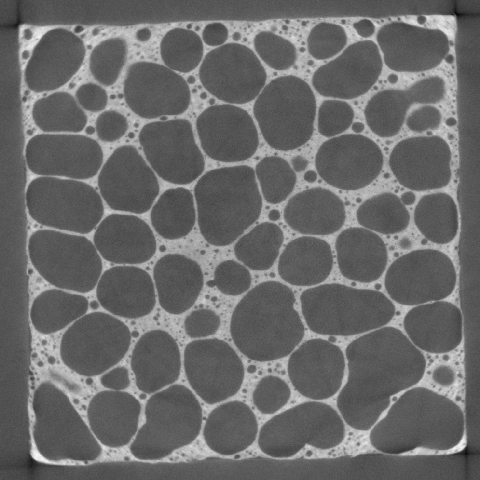 |
FCM for Geometrically and Materially Nonlinear Analysis of Metal Foams
| Project team leader | Dr. rer. nat. Ralf-Peter Mundani Stefan Kollmannsberger, M.Sc. Prof. Dr. rer. nat. Ernst Rank |
| PhD student | Dipl.-Ing. Dominik Schillinger, M.Sc. |
Project Description
| The conventional finite element method requires the discretization of the domain of interest into a finite element mesh, whose boundaries have to coincide with the physical boundaries of the problem. While this constraint can be easily achieved for most applications of solid mecha- nics, it becomes a huge problem for structures with very complex boundaries, whose geometry is only available in voxel format (see Fig. 1). Mesh generation algorithms that are able to transfer voxel based geometry discriptions into finite element meshes are error prone, often yield largely distorted elements and are computationally very expensive, so that usually more than 90% of the total FE analysis time is consumed by mesh generation alone. |
|
The recently introduced Finite Cell Method (FCM) is targeted at circumventing the complete mesh generation. Its main feature is the combination of high-order Legendre based finite elements by a fictitious domain approach, which allows the extension of the physical domain beyond its boundaries. It complements the weak formulation of the mechanical problem by an additional function α, which is 1 inside the physical domain and 0 outside. Thus, the boundary information is implicitly incorporated into the functional and does not need to be represented by the mesh. Since the extension of solution fields are smooth beyond the physical domain, FCM can preserve exponential convergence of conventionl p-FEM. |


Fig. 5: Linear elastic FCM analysis of a femur (voxel geometry, high-order 3D hex elements, von Mises stress).
Publications
- Düster, A.; Parvizian, J.; Yang, Z,; Rank, E.;
The FInite Cell Method for Three-Dimensional Problems of Solid Mechanics. Computer Methods of Applied Mechanics and Engineering 197, 3768 - 3782, 2008. - Parvizian, J.; Düster, A.; Rank, E.;
Finite Cell Method: h- and p- extension for embedded domain methods in solid mechanics. Computational Mechanics 41, 122-133, 2007.
Contact: Dipl.-Ing. Dominik Schillinger, M.Sc.
